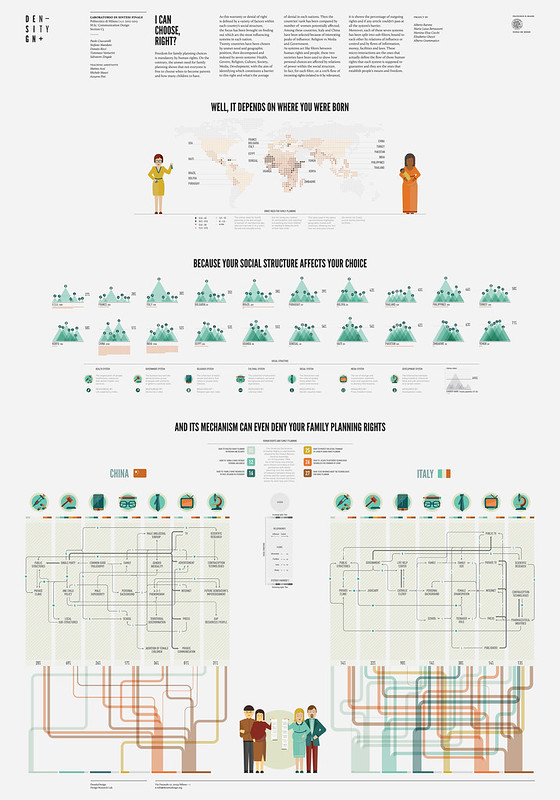Poster: I can choose, right?
Freedom for family planning choices is mandatory by human rights. On the contrary, the unmet need for family planning shows that not everyone is free to choose when to become parents and how many children to have.
As this warranty or denial of right is defined by a variety of factors within each country’s social structure, the focus has been brought on finding out which are the most influencing systems in each nation. Twenty countries have been chosen by unmet need and geographic position, then decomposed and indexed by seven systems: Health, Govern, Religion, Culture, Society, Media and Development, with the aim of identifying which constitutes a barrier to this right and what’s the average of denial in each nations. Then the countries’ rank has been compared by number of women potentially affected.
Among these countries, Italy and China have been selected because of interesting peaks of influence: Religion vs Media and Government. As systems act like filters between human rights and people, these two societies have been used to show how personal choices are affected by relations of power within the social structure. In fact, for each filter, on a 100% flow of incoming rights (related to a system by pertinence), it is shown the percentage of outgoing rights and if any article couldn’t pass at all the system’s barrier. Moreover, each of these seven systems has been split into sub-filters, bound to each other by relations of influence or control and by flows of information, money, facilities and laws. These micro-interactions are the ones that actually define the flow of those human rights that each system is supposed to guarantee and they are the ones that establish people’s means and freedom.
Thanks to this visualization we’ve been able to see the existence of a controversy about family planning’s themes as long as systems do not line up but shape peaks according to their different points of view (eg. In Italy, there’s a highest gap between medicine, that tries to provide accessibility to every contraception method, and religion, that claims no contraception should be allowed except for abstinence or temperature control).
Report: Unborn discussion
Taking as starting point the two interesting and controversial cases shaped on the poster we narrowed the research on the Italian debate; moreover, in the complexity of the issue, we found abortion to be the most interesting point to focus on, being a borderline case within family planning controversy. In fact, it highlights the debate and extremes the positions both ethically, ideologically and juridically, particularly because of the clash of two fundamental human rights: the right to live and the right to free family planning respectively granted by the Constitution and by the “Law 194” (Legge n.194, 22 Maggio 1978).
Given that, in this step we were not interested in finding out how the clashing of points of view develops, but in the approach to the controversy: we aimed to define if the presence of this discussion is expression of confrontation or if it’s just stance taking.
For this reason we divided the research protocol into three branches as we identified three different relationships among the actors of the controversy:
-the first one is built on negotiation and it has been analyzed within the Wikipedia discussion page about abortion, as it is the more or less stable result of a negotiation among juxtaposed sides in order to gain a encyclopedic knowledge. In this context we also find out pro-life IPs behavior of adding or removing contents with a spoiling and sided attitude.
-the second type of dialogue is referential and corresponds to actor’s willingness to link towards others; for studying this we visualized the actors’ networks and highlight the fact that opinion leaders (typically institutional and information sites) are not actively linking, therefore not willing to dialogue towards others. Moreover referentiality feeds only the relation internal to each side, which tends to close and develop one-way dialogue instead of true confrontation.
-the third and last type of dialogue is the confrontation one, and expresses the actor’s will to gather various opinions: it is built through the possibly of adding comments within the page itself. Here we noticed weak dialogue as the trend is to comment mainly on same-oriented sites, and even in those cases where it succeeds, it is still hindered by the semantic barrier.
In conclusion, except Wikipedia registered users and and neutral websites that gathers different opinions, the sides within the controversy are just entrenching in their own belief and not willing to build dialogue with opposite orientations: it turned out to be an unborn dialogue.
Video: I can choose, right?
The last part of our project consists of communicating the findings of our research to the public through a video narration.
It has been built using different narration levels according to the deepening of our research.
The first level introduces the user to an ideal world of human rights related to family planning; then it is replaced by second level, defined as the real world, where we show the official indexes analyzed in the poster.
Hereafter, is shown the third part of the analysis, carried out on unofficial data, that we have perceived and collected thanks to digital methods. This part, presented as the deepest level, is metaphorically explained as a movement from self beliefs towards conscious choices. Accordingly the three dialogues are characterized in three vehicles moving on this street, and carrying around personal opinions.
In the end none of them gets to a real confrontation of ideas, they all stop along the way: the sooner the dialogue stops, the more self-oriented opinions are.
Authors
Alberto Barone
Maria Luisa Bertazzoni
Martina Elisa Cecchi
Elisabetta Ghezzi
Alberto Grammatico



